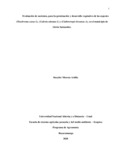Mostrar el registro sencillo del ítem
Evaluación de sustratos, para la germinación y desarrollo vegetativo de las especies (Theobroma cacao L), (Cedrela odorata L) y (Clathrotropis brunnea A), en el municipio de Girón Santander.
| dc.contributor.advisor | Mansilla Sosa, Oscar Said | |
| dc.coverage.spatial | cead_-_bucaramanga | spa |
| dc.creator | Moreno Ardila, Sneyder | |
| dc.date.accessioned | 2020-07-03T00:00:25Z | |
| dc.date.available | 2020-07-03T00:00:25Z | |
| dc.date.created | 2020-06-01 | |
| dc.identifier.uri | https://repository.unad.edu.co/handle/10596/35151 | |
| dc.description.abstract | La presente investigación ejecutó la evaluación de diferentes tipos de sustratos, para germinación y desarrollo vegetativo de Cacao (Theobroma cacao L.), Cedro (Cedrela odorata L.) y Sapan (Clathrotropis brunnea Amshoff), producidas en el vivero El Edén ubicado en la zona de influencia de la represa Hidrosogamoso (Topocoro) en Girón, Santander. Previamente a la evaluación se realizó actividades de reconocimiento, ubicación y seguimiento fenológico reproductivo de los árboles forestales semilleros (C. odorata L y C. brunnea A) en la zona de influencia del embalse, para posterior recolección de semillas, mientras las semillas de (T. cacao L- IMC67) se obtienen de árboles padres en la parcela del vivero La Granja en el casco urbano del municipio de San Vicente de Chucurí. Se formalizó un diseño experimental completamente al azar, trabajando 5 tratamientos con diferentes sustratos y 25 repeticiones para cada tratamiento, aplicado para cada especie. Como componentes de los sustratos se emplearon: Suelo ¨horizonte A¨, Cascarilla de arroz, Gallinaza compostada y Estiércol bovino. Se evaluaron el porcentaje de germinación, porcentaje de supervivencia, número de hojas, altura y diámetro; los registros se tomaron durante 90 días, tiempo estimado en que las plántulas estuvieron listas para su trasplante a campo. Los datos obtenidos se procesaron por medio de análisis de varianza (ANOVA) en el programa (Rwizard) para medir las diferencias significativas y determinación sobre la mejor opción de sustrato para producir estas especies de importancia para la región. Este trabajo tiene como finalidad de dar a conocer a los agricultores la mejor opción de sustrato con componentes orgánicos que la zona brinda, para emplearlos en los procesos de germinación de semillas y desarrollo de las plántulas en vivero, siendo puente de impulso al uso de estas alternativas de producción y mejora en la calidad de sus proyectos productivos con mesura al medio ambiente alcanzando igualdad social, económica y sustentabilidad ambiental en todo proceso. En la especie T. cacao L los resultados mostraron que los tratamientos T2 y T3 fueron significativamente mejores en términos de desarrollo vegetativo; mientras en el la especie C. odorata L los tratamientos que evidenciaron un mejor comportamiento en el desarrollo vegetativo fueron los T4 y T5 y por último en la especie C. brunnea A evidencio un desarrollo vegetativo similar en todos los tratamientos evaluados, sin diferencias estadísticas significativas. | spa |
| dc.format | ||
| dc.title | Evaluación de sustratos, para la germinación y desarrollo vegetativo de las especies (Theobroma cacao L), (Cedrela odorata L) y (Clathrotropis brunnea A), en el municipio de Girón Santander. | |
| dc.type | Proyecto de investigación | |
| dc.subject.keywords | Fisiología vegetal | spa |
| dc.subject.keywords | Recursos naturales | spa |
| dc.subject.keywords | Suelo | spa |
| dc.subject.keywords | Materia orgánica | spa |
| dc.subject.keywords | Agricultura | spa |
| dc.description.abstractenglish | The present investigation carried out the evaluation of different soils as substrates, for germination and vegetative development of Cacao (Theobroma cacao L.), Cedro (Cedrela odorata L.) and Sapan (Clathrotropis brunnea Amshoff), produced in the El Edén nursery located in the area of influence of the Hidrosogamoso (Topocoro) dam in Girón, Santander. Prior to the evaluation, activities of reconnaissance, location and reproductive phenological monitoring of the seed forest trees (C. odorata L and C. brunnea A) were carried out in the area of influence of the reservoir, for subsequent seed collection, while the seeds of (T. cocoa L- IMC67) are obtained from parent trees in the La Granja nursery plot in the urban area of the municipality of San Vicente de Chucurí. A completely randomized experimental design was formalized, working 5 treatments with different substrates and 25 repetitions for each treatment, applied for each species. The following were used as components of the substrates: ¨horizonte A¨ soil, rice husk, composted chicken manure and composted bovine. The germination percentage, survival percentage, number of leaves, height and diameter were evaluated, the records were taken for 90 days, the estimated time when the seedlings were ready for transplantation in the field. The data obtained was processed by means of analysis of variance (ANOVA) in the program (Rwizard) to measure the significant differences and determination of the best substrate option to produce these species of importance for the region. The purpose of this work is to inform farmers of the best option of substrate with organic components that the area provides, to be used in the processes of seed germination and seedling development in the nursery, being a driving bridge to the use of these production alternatives and improvement in the quality of their productive projects with a measure of the environment, achieving social, economic equality and environmental sustainability in all processes. In the T. cacao species, the results showed that the treatments T2 and T3 were significantly better in terms of vegetative development; while in the C. odorata L species the treatments that showed a better behavior in the vegetative development were T4 and T5 and finally in the C. brunnea A species I show a similar vegetative development in all the evaluated treatments, without significant statistical differences. | spa |
| dc.subject.category | Agronomía | spa |
Ficheros en el ítem
Este ítem aparece en la(s) siguiente(s) colección(ones)
-
Agronomía [574]















